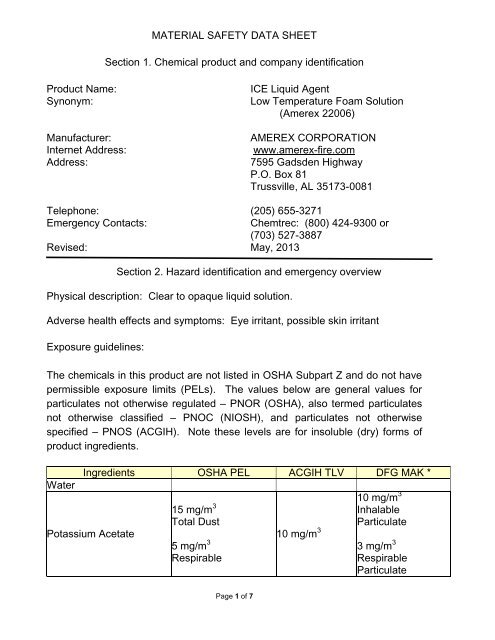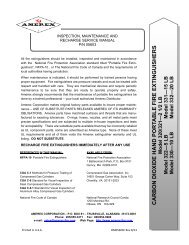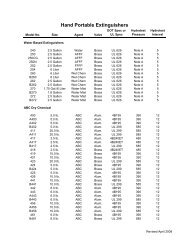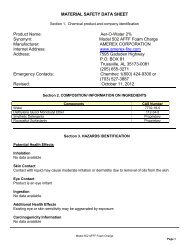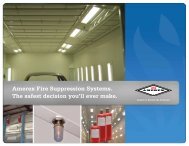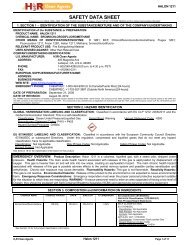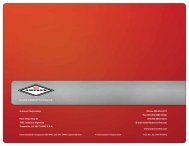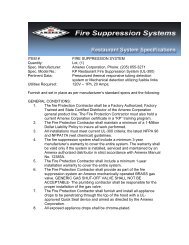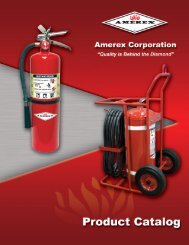ICE Liquid Agent ENGLISH - Amerex Corporation
ICE Liquid Agent ENGLISH - Amerex Corporation
ICE Liquid Agent ENGLISH - Amerex Corporation
You also want an ePaper? Increase the reach of your titles
YUMPU automatically turns print PDFs into web optimized ePapers that Google loves.
MATERIAL SAFETY DATA SHEETSection 1. Chemical product and company identificationProduct Name:Synonym:Manufacturer:Internet Address:Address:<strong>ICE</strong> <strong>Liquid</strong> <strong>Agent</strong>Low Temperature Foam Solution(<strong>Amerex</strong> 22006)AMEREX CORPORATIONwww.amerex-fire.com7595 Gadsden HighwayP.O. Box 81Trussville, AL 35173-0081Telephone: (205) 655-3271Emergency Contacts:Chemtrec: (800) 424-9300 or(703) 527-3887Revised: May, 2013Section 2. Hazard identification and emergency overviewPhysical description: Clear to opaque liquid solution.Adverse health effects and symptoms: Eye irritant, possible skin irritantExposure guidelines:The chemicals in this product are not listed in OSHA Subpart Z and do not havepermissible exposure limits (PELs). The values below are general values forparticulates not otherwise regulated – PNOR (OSHA), also termed particulatesnot otherwise classified – PNOC (NIOSH), and particulates not otherwisespecified – PNOS (ACGIH). Note these levels are for insoluble (dry) forms ofproduct ingredients.WaterIngredients OSHA PEL ACGIH TLV DFG MAK *Potassium Acetate15 mg/m 3Total Dust5 mg/m 3Respirable10 mg/m 3InhalableParticulate10 mg/m 33 mg/m 3RespirableParticulatePage 1 of 7
*German regulatory limits; NR = Not RegulatedHazard symbols:HAZARD SYMBOLS: WHMIS (Canadian workplace hazardous materialsidentification system)D2B – Product may irritate skin or mucous membranesSection 3. Composition/information on ingredientsWater (H20) RemainderChemical formula/Name Weight % CAS #Water >50 7732-18-5Potassium Acetate < 45 127-08-2Glycol Ether < 1 112-34-5Phosphate ester < 1 naFluorosurfactant < 1 proprietarySection 4. First aid measuresEye Exposure: Irrigate eyes at eye wash station and repeat until pain free or atleast 15 minutes. Seek medical attention immediately.Skin Exposure: In case of contact, wash with plenty of soap and water.Inhalation: If respiratory irritation or distress occurs remove victim to fresh air.Seek medical attention if irritation develops or persists.Ingestion: If victim is conscious and alert, give 2-3 glasses of water to drink. Onlyinduce vomiting on the advice of medical personnel. Seek immediate medicalattention. Do not leave victim unattended. If victim is unconscious, lay victim onside with head lower than waist to prevent aspiration of swallowed product. Ifvomiting occurs and the victim is conscious, give water to further dilute thechemical.Medical conditions possibly aggravated by exposure: none foundPage 2 of 7
Section 5. Fire fighting measuresExtinguishing media: solution is non combustible and non flammable – productis an extinguishing agentUnusual fire/ explosion hazards: in a fire this material may decompose, releasingoxides of carbon (see Section 10)Insensitive to mechanical impact or static discharge.HMIS hazard ranking: health 1, flammability 0, reactivity 0Section 6. Accidental release measuresLarge spills (one container or more) should be addressed by hazardousmaterials technicians following a site – specific emergency response plan andtrained in the appropriate use of PPE. Clean up released material using sorbentsocks for containment, followed by sorbent material inside containment. Ifdeemed necessary, wear full face APR or PAPR with organic vapor cartridges(Section 8). Bag and drum for disposal. If product is used and/or contaminateduse PPE and containment appropriate to the nature of the mixture. Preventmaterial from entering storm sewer.Handle and dispose of as a hazardous waste unless testing indicates otherwise.Decontaminate with detergent and water.Section 7. Handling and storageAvoid eye, respiratory, and skin exposure. Store in cool, dry place away fromoxidizing agents and use appropriate PPE (personal protective equipment) whenhandling, and wash thoroughly after handling (Section 8). Keep product inoriginal container until packaging for use as extinguisher. Clean used equipmentbefore storage. Use this product only in well ventilated areas. Do not mix withother extinguishing agents.Section 8. Exposure controls/ personal protectionDuring the application of this product against fires, exhaust gases and theproducts of incomplete combustion (PICs) are the principal respiratory hazards.In the manufacture of extinguishers, automated systems and point sourcePage 3 of 7
ventilation controls sufficiently minimize respiratory exposure. Employers andemployees must use their collective judgment in determining occupationalsettings where the use of a respirator is prudent. The need for respiratoryprotection is not likely for the intended short-term use of the product in wellventilated areas.Respiratory protection: In high concentrations or poor ventilation areas use airpurifyingrespirator (APR) or powered air-purifying respirator (PAPR) with HEPAcartridges when handling dry ingredients for low or short-term exposure. Usepositive pressure supplied air respirators (SAR) or self contained breathingapparatus (SCBA) for high volume liquid applications.Eye protection: wear chemical goggles or other splash protection.Skin protection: use nitrile, latex, or similar gloves and coveralls. Good personalhygiene practices essential, such as avoiding food, tobacco products, or otherhand-to-mouth contact when handling. Wash thoroughly after handling product.Section 9. Physical and chemical propertiesAppearance: Clear to opaque liquid, odorlessSpecific gravity: 1.20 at 20 o C (approximate)Solubility: soluble in waterNon-flammableFlash point: not applicableVapor pressure:
Section 11: Toxicological InformationTarget organs in man: respiratory system, eyes, skin. This product is a mildirritant to epithelial tissue, and may aggravate dermatitis. Ingestion may causegastrointestinal injury. No information was found indicating the product causessensitization.Acute toxicity: Potassium Acetate: oral rat LD 50 : 3250 mg/kg body weight.Chronic toxicity: This product's ingredients are not considered as "probable" or"suspected' carcinogens by OSHA, ACGIH or IARC.Reproductive toxicity: This product's ingredients are not known to havereproductive or teratogenic effects.Section 12. Ecological informationEcotoxicity: weak environmental toxin, specific negative effects unknownPersistence/Degradability: moderate biodegradation in soil, rapid photolyticdegradation in airBioaccummulation: extent unknown, unlikelyMobility in soil: water soluble, slow to evaporate, may reach groundwaterSection 13. Disposal considerationsThis product is not a RCRA characteristically hazardous or listed hazardouswaste. Dispose of according to state or local laws, which may be more restrictivethan federal laws or regulations. Used product may be altered or contaminated,creating different disposal considerations.Section 14. Transportation informationThis product is not a hazardous material under U.S. Department ofTransportation (DOT) 49 CFR 172, and is not regulated by the DOT, IMO, lATA,Page 5 of 7
RID/ADR, or Canada's TDG.Section 15. Regulatory informationInternational Inventory StatusContains ingredients on the following inventoriesCountry(ies) Agencv StatusUnited States of America TSCA 8(b): Potassium acetate YesCanada DSl YesEurope EINECS/ELINCS YesAustralia AICS YesJapan MITI YesSouth Korea KECL YesEuropean Risk and Safety phrases:EU Classification: XN IrritantR Phrases: 36/37/38 Irritating to eyes, respiratory system and skinS Phrases: 26 In case of contact with eyes, rinse immediately withplenty of water and seek medical advice36 Wear suitable protective clothing39 Eye/face protectionU.S. federal regulatory information:None of the chemicals in this product are under SARA reporting requirements orhave SARA threshold planning quantities (TPQs) or CERCLA reportablequantities (RQs). None of the chemicals in this product are listed as HazardousSubstances under the Clean Water Act or as hazardous air pollutants under theClean Air Act.State regulatory information:Chemicals in this product under specific State regulations, as denoted below:California - Permissible Exposure Limits for Chemical Contaminants: NoneFlorida - Substance List: NoneMassachusetts - Substance List: NoneMinnesota - List of Hazardous Substances: NoneNew Jersey - Right to Know Hazardous Substance List: NonePennsylvania - Hazardous Substance List: NonePage 6 of 7
California Proposition 65: No component is listed on the California Proposition65 list or the No Significant Risk Level List.Section 16. Other informationThis MSDS conforms to requirements under U.S., U.K., Canadian, Australian,and EU regulations or standards, and conforms to the 2003 ANSI Z400.1 format.The information herein is given in good faith but no warranty, expressed orimplied, is made. Updated by Shaun A. Crawford, PhD,CIH.Page 7 of 7


